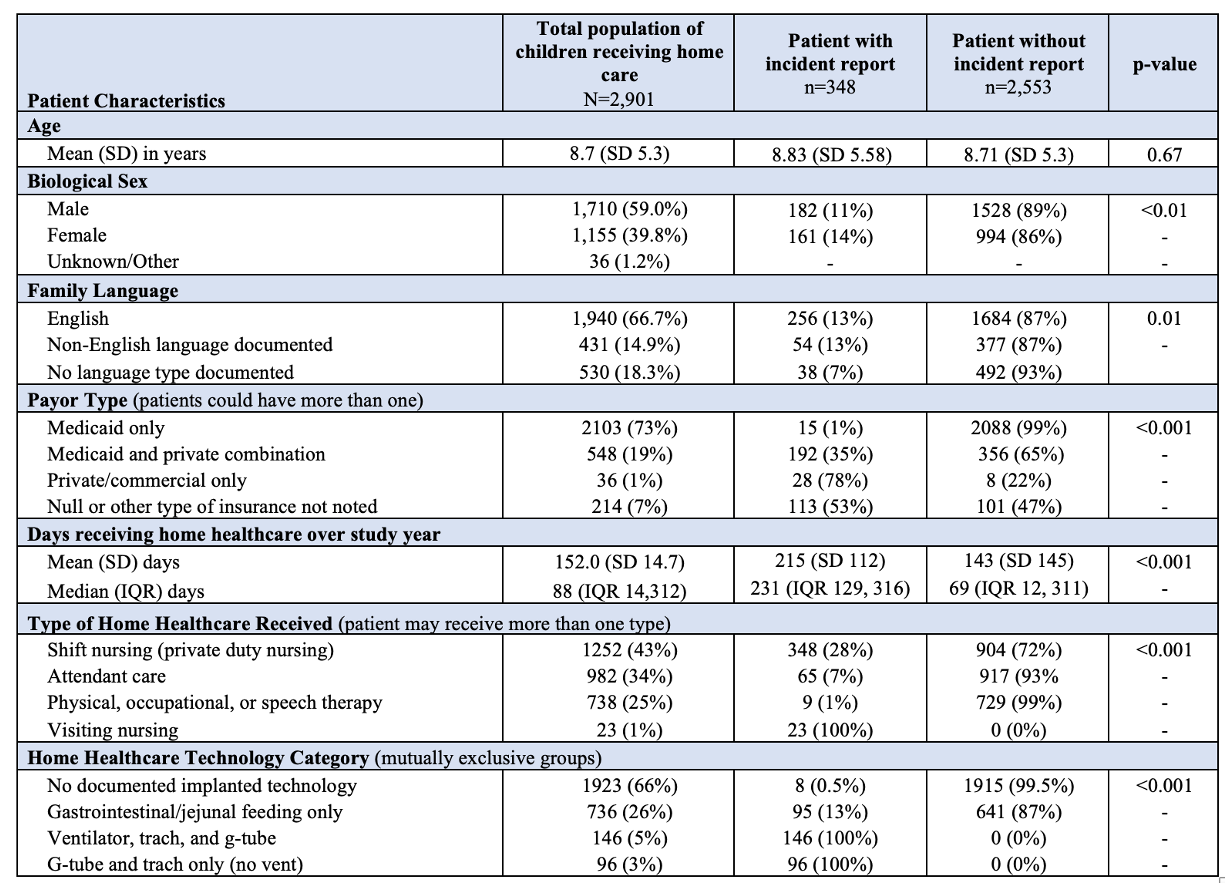Children with Chronic Conditions 1
Session: Children with Chronic Conditions 1
498 - Patient Safety Events in Children Receiving Home Healthcare
Sunday, April 27, 2025
8:30am - 10:45am HST
Publication Number: 498.5590
Carolyn C.. Foster, Ann & Robert H. Lurie Children's Hospital of Chicago, Chicago, IL, United States; Peter Walsh, Ann & Robert H. Lurie Children's Hospital of Chicago, Chicago, IL, United States; Michelle S. High, Ann & Robert H. Lurie Children's Hospital of Chicago, Chicago, IL, United States; Leonardo Barrera, Ann & Robert H. Lurie Children's Hospital of Chicago, Chicago, IL, United States; Cara L. Coleman, UVA School of Medicine INOVA Campus, Lorton, VA, United States; Margaret M.. Storey, DePaul University, Department of History, Evanston, IL, United States; Griselle Vanessa. Rodriguez, Family Voices, Bear, DE, United States; Nikki Montgomery, Ann & Robert H. Lurie Children's Hospital of Chicago, Euclid, OH, United States; Tara Lagu, Northwestern Feinberg School of Medicine, Cape Elizabeth, ME, United States; Carol Haywood, Northwestern University The Feinberg School of Medicine, Chicago, IL, United States; Kathleen E. Walsh, Boston Children's Hospital, Boston, MA, United States; Danny Valdez, Indiana University School of Public Health, Bloomingtkn, IN, United States; Alisa Khan, Boston Children's Hospital, Boston, MA, United States; Nicole Werner, Indiana University School of Public Health Bloomington, Bloomington, IN, United States

Carolyn C. Foster, MD, MS (she/her/hers)
Assistant Professor of Pediatrics
Ann & Robert H. Lurie Children's Hospital of Chicago
Chicago, Illinois, United States
Presenting Author(s)
Background: Healthcare safety in the home and community is often overlooked even though care plans prescribed for children are becoming increasingly complex in community settings. Patient safety incidents in pediatric home healthcare (HHC) have been rarely described. Categorizing HHC incident reports is a first step towards developing interventions to prevent their occurrence.
Objective: Identify the rates and types of incident reports within a national pediatric HHC sample.
Design/Methods: This one-year retrospective mixed-methods cohort study analyzed 2,901 patients < 21 years old receiving from Team Select Home Care, a HHC company across 11 states from 9/1/22-9/31/23. We quantified the rate of patient-level incidents reported by agency staff. We used the National Coordinating Council for Medication Error Reporting and Prevention (MERP) Index to code which incidents met criteria as a patient safety event (e.g., harmful error, non-harmful error, hazard etc.). We used bivariate analyses to compare patient characteristics and incident rates.
Results: We identified 2,901 children who received a median of 98 [interquartile range (IQR) 14, 312] days of HHC. The most common HHC care type received was shift nursing (n=1252, 43%); 44% (n=978) of the sample had implanted medical technology (Table 1). A total of 348 (12%) children in the sample had 685 unique reported incidents. The number of incident reports ranged from 0-20 per child (median [IQR] 1[1,2]). A total of 315 (46%) incidents were MERP events, including 172 harmful errors (25.1%), 111 nonharmful errors (16%), 26 hazards (4%), and 6 nonpreventable harmful events (1%) (Table 2). Errors (all types) most frequently involved medications (n=109, 39%) and implanted device care (n=93, 33%). Harmful errors most frequently caused skin injuries (n=77, 45%) and falls (n=30, 17%). About half of all errors required additional monitoring (n=135, 48%), with 16% (n=45) leading to emergency care (Table 3). Among all error types, 51% (n=352) involved both the HHC staff and family caregiver, and half (n=152, 54%) had documentation that the event was communicated to a provider known to the patient. Incidents were more likely to occur in children with tracheostomies and/or ventilators and using nursing-level care (Table 1).
Conclusion(s): More than 1 in 10 children had an incident reported by HHC staff, of which about half were safety related. While this work is limited by passive reporting that does not include family voice, it provides new data about pediatric healthcare safety. Further work should explore what factors contribute to incident reporting and resolution.
TABLE 1. Characteristics of children receiving home healthcare comparing those with versus without incident reports

TABLE 2. Pediatric Home Healthcare Incident Report Categorization
.png) Total incidents count was N=685.
Total incidents count was N=685.TABLE 3. Types of Patient Safety Incident Outcomes Reported in Pediatric Home Healthcare
.png)
TABLE 1. Characteristics of children receiving home healthcare comparing those with versus without incident reports

TABLE 2. Pediatric Home Healthcare Incident Report Categorization
.png) Total incidents count was N=685.
Total incidents count was N=685.TABLE 3. Types of Patient Safety Incident Outcomes Reported in Pediatric Home Healthcare
.png)

